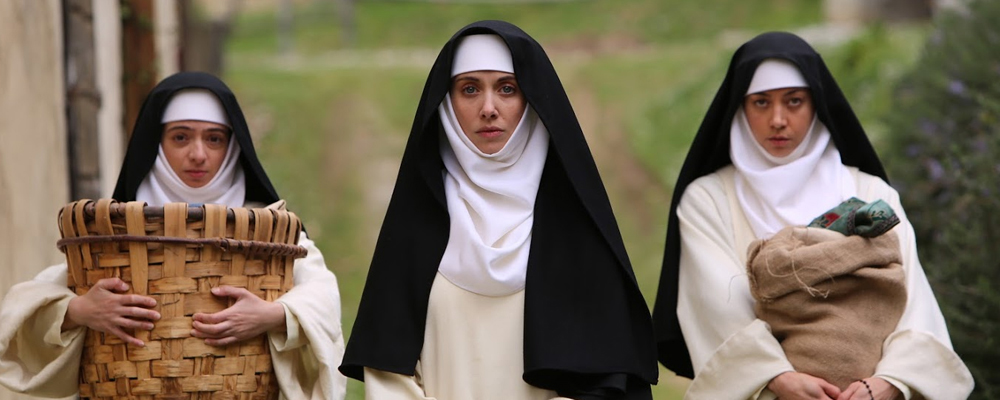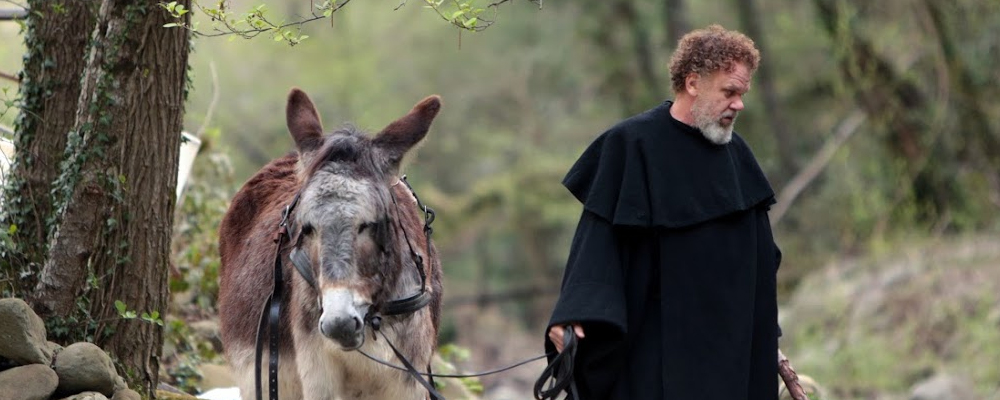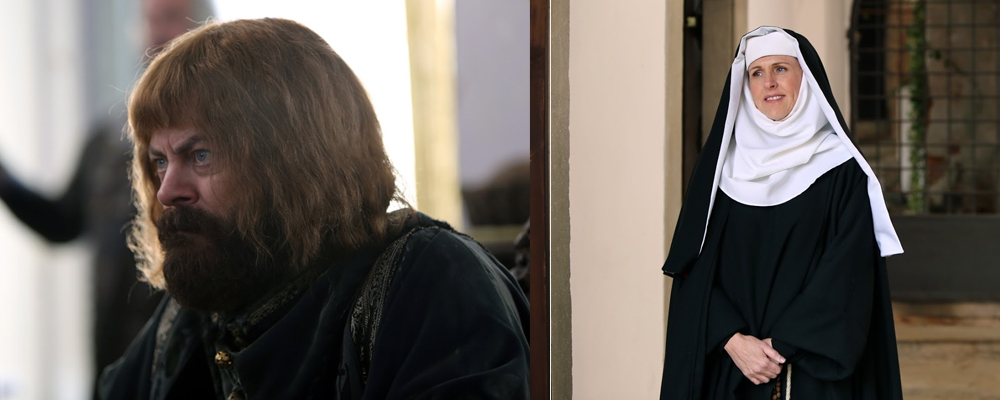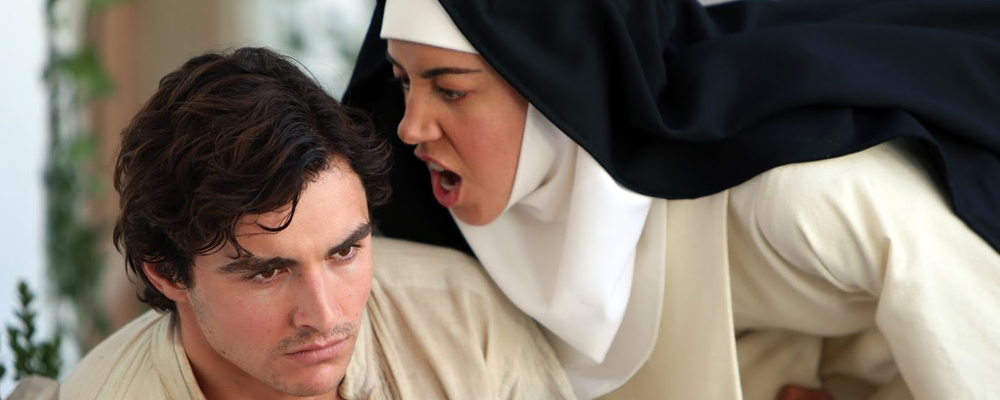The Cast of ‘The Little Hours’ Talk Lampooning the 14th Century Through an Improvisational Lens
Frederick Mintchell
Writer/director Jeff Baena’s raucous new comedy, “The Little Hours,” is inspired by selections from Boccaccio’s Black Plague-era classic “The Decameron” and was shot on location in Tuscany. In the film, medieval nuns Alessandra (Alison Brie), Fernanda (Aubrey Plaza) and Ginevra (Kate Micucci) lead a simple life in their convent. Their days are spent chafing at monastic routine, spying on one another and berating the estate’s day laborer.
After a particularly vicious insult session drives the peasant away, Father Tommasso (John C. Reilly) brings on new hired hand Massetto (Dave Franco), a virile young servant forced into hiding by his angry lord. Introduced to the sisters as a deaf-mute to discourage temptation, Massetto struggles to maintain his cover as the repressed nunnery erupts in a whirlwind of pansexual horniness, substance abuse and wicked revelry.
Though the film is set at a convent, Baena is quick to point out that “The Little Hours” is not a religious satire.
“This is not an attack on religion. This is an adaptation of a book that, to some extent, was satirizing religion, but was more satirizing people and culture in general. Instead of finding faults in the Church, it’s about the richness of life which is more interesting to me. That time period isn’t something that should be looked at as dry and boring. It’s actually fun and bawdy and crazy and wild.”
Brie agrees with Baena and was more than happy to join the project.
“I like dark comedy and stuff that is a bit edgy, so this was right up my alley. It has this bizarre tone that you’ve not seen before. I like when comedy is mixed with ‘real’ moments and depth. This movie tows that line in a very cool way where it’s raucous and raunchy but yet real too. I love my scene with Paul Reiser because my character is going through some very real emotions as well.”
The role also brought out some very organic reactions from co-star Molly Shannon, as well as memories of a real-life nun who might have been instrumental in her formative years.
“We did have a nun when I was in grade school named Sister Rosemary. She seemed really unhappy and I found her fascinating because she seemed so miserable. I used to go pray at her convent after school for extra credit and I’d study her. She got out and was seen on this golf course in a mini-skirt whooping it up with one of my classmates’ fathers. I was like, ‘yah, she’s free! She got out!’”
The cast assembled by Baena was very familiar with each other. Baena had worked with Plaza, Reilly and co-star Shannon in his directorial debut, “Life After Beth“ while Plaza and co-star Nick Offerman worked together on “Parks and Recreation” to name just a couple examples. This previous camaraderie created a family-like atmosphere on the set. There was such a camaraderie that it didn’t feel like work for Shannon.
“There aren’t a lot of projects where you’re working with a lot of people around your own age – within 10, 15 years,” she says. “I’ve done TV shows where you’re with a bunch of little kids and it can be lonely. This was all fun people and since we were shooting in Italy, we all went out to dinner every night together. If we were shooting in L.A., we’d all probably just go to our houses after. It almost felt like a theater camp. We were all staying at the same hotel so we’d all hang out.”
Brie elaborates. “We were all isolated together in Tuscany which is kind of isolated – small towns, small villages. We’re in a different time zone so no one is really talking to people in L.A. At the same time, we were sort of speaking our own language. It seems like we’re speaking contemporarily in the movie, but Jeff had a stern set of rules for things we could not say. We had developed our own language so when other actors got there in week three or so like Jon Gabrus and Adam Pally, they were like, ‘you guys are super weird.’ It was this weird vibe that we cultivated together. It did feel like camp because it was so much fun, but since we were together for so many hours, you’d turn to someone and tell them this really deep story about yourself.
Plaza agrees that the set was a fun work environment. “I’d say that’s a really great description of how it felt. A lot of us had worked together before. There were couples in the mix [Allison Brie and Dave Franco are married]. It felt like a really good group of people to hang. It was a lot of work but it was really fun.”
Franco concurs that this familiarity helped the actors disappear into their roles more easily. “Because the entire movie is improvised, it was necessary that we felt really comfortable with one another because when you’re improvising, you want to feel free to take risks and do things that make you look stupid. That’s a lot easier to do around people that you trust.”
Though the film is set in the 1300s, the actors weren’t required to do a lot of homework on the time period.
Franco explains Baena’s reasoning. “I kept asking Jeff what research I could do or should be doing and he said to ‘not overthink it. It’s not about the time period or how they talked. It was more about the human connection. Even though the movie is set in the fourteenth century, it’s about the relationships. I want you to speak in your natural cadence and not some flowery dialect.’ It’s really just about the human connection.”
While the dialogue might not be what one would expect from a film set in the fourteenth century, the behavior of the nuns is not what anyone would expect from a film set in any century. “None of the nuns in the film are religious and don’t want to be there,” Plaza clarifies. “In that time period, women were sent to convents for political reasons or financial reasons and not necessarily religious reasons.
[Our characters] might be considered ‘bad’ for nuns, but as women, they’re just expressing themselves. It’s about them behaving the way they’re not supposed to be.” Plaza adds, “nun habits can feel very depressing because they’re weighing you down literally. Only having your face exposed is very hard. Psychologically, it helped us get into character because we were totally desexualized.”
The nun habits also helped Brie delve into her character.
“The habit is very oppressive. I found myself very depressed to be wearing it. My character is in that mental state for a lot of the movie so it helped a lot. It changed the way I went about performing in the movie because I’m a very physical person. [Physicality is] one of my biggest tools that I use often. It’s the tool I always reach for in the bag. To have that physicality taken away from you and to have that sexuality robbed from you, it was an interesting challenge in minimalism in conveying ideas with as little movement as possible.
Though there was a 28-page script, it was more of an outline to encourage the actors to improvise. Baena walks us through the process.
“The outline described the action of the scene as well as the content of the conversation. It wasn’t like I put three people in a scene and said, ‘go talk. I come at improv through the eyes of a writer. My main goal in using improv is to get so that actors are speaking in their own language and their own words so it doesn’t seem forced. It’s more organic and authentic to who they are. Another aspect is that the actors are more engaged. Instead of waiting to say your line after the other actor says a line, you have to wait to hear what the other actor is going to say.”
When working with a who’s who cast of comedy, there were times when the actors couldn’t help but break character.
For Plaza, her communion scene took a while to film since she couldn’t keep a straight face. “There was one scene where I couldn’t keep it together. It might have been the first day and we’re shooting one of the services where we’re in line to do communion. There was something about waiting in line to see John C. Reilly pretending to be a priest and looking like that. Every time I got up to him, I’d kind of start laughing and then he’d start laughing. That went on for way too long. Every time I’d get back in line, I’d think to myself, ‘don’t laugh. Don’t laugh.’ And I just did every time.”
Franco’s toughest scene to film involved a conversation with his master. “I couldn’t hold it together during the scene where [Nick] Offerman is telling me all the different ways he’s going to torture me. The camera was on him so I wasn’t even on camera, but I was laughing so hard I was crying. I kept ruining his takes. He doesn’t have to say anything and he just kills me.”
Believe it or not, Shannon’s toughest scene involved her former “Saturday Night Live” co-star, Fred Armisen.
“When we’re all in the church, Fred is telling us all the sins we’ve committed. One of the sins he said I committed was mischief of the heart and I loved it. It’s the sweetest thing and I really could not stop laughing. Fred could not stop laughing and then John would start laughing.”
For most of us, confessing is something to dread. For Brie however, the confessional scene was one of her favorites.
“We did the confessional scene during the first week. Kate did hers first and then Aubrey. We were sort of improvising and Aubrey came in and said almost the exact same thing that Kate said. We were behind the monitor and I just lost it and could not keep it together. Also watching Dave do his scene with John when he’s talking about ‘her sex in his mouth.’
Many actors adhere to the method style of acting where they stay in character even when not shooting. Franco admits he took method acting to a whole new level.
“I have to be honest. I got a little tipsy for the confessional scene with John C. Reilly. I was supposed to be very drunk in the scene so I got halfway there. I wanted to go method on that scene.”
When asked if he went method to get to the core of his sex addiction, Franco demurs. “I didn’t go method on the entire core of the character.”
Plaza, on the other hand, jokingly admitted she was more than happy to explore her character’s sex addiction. “I did. I always go method with sex addiction before every role I play.”
“The Little Hours” opens in select theaters June 30.




